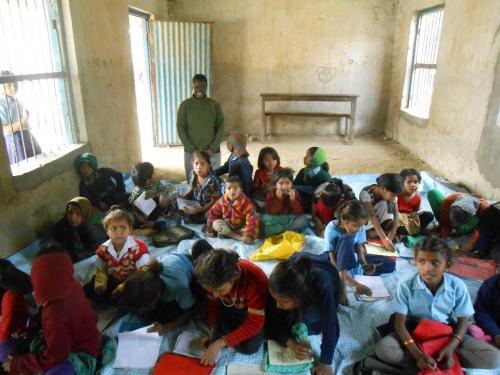
As a VSO teacher trainer, my FIRST step into my 12 focus schools will be to train teachers on how to make the learning environment conducive and motivating for teaching and learning. However, I began my VSO Education experience at a number of schools in Parsa District, conducting abarefoot assessment, i.e. an initial observation, based on a number of indicators,in order to understanda situation before a project starts. I found the students in all twelve sampled schools,eager to learn;a bellrings-an indication that it’s time to begin another lesson.
A teacher and I went to a grade six class to conduct an English lesson and the students all stoodup, saying “Namaste”, I replied back “Namaste, please be seated.” To my surprise, all the students remained standing, staring at me and then at their teacher.I wondered what I should do next toget them seated. I looked at the teacher who realizedthat she should say something,“baitoljau” and the students sat.
The teacher went on to teachEnglish,but it was all mixed up. The teacher then realized that she should explain something to me and walked to the back where I wassitting observing and whispered, “I have to teach this in Bhojpuri for them to understand.” The teacher then went on to teach English in Bhojpuri.
In Kenya, my home country, schedules are posted on the classroom walls and students know which lesson the teacher will be teaching at any given time; when the teacher gets in,they greet him/her according to the language of the lesson to be taught.eg, “Goodmorning sir/madam,welcome to class six.” Or if it is Kiswahili lesson, which is my country’s national language, students would say, ”Shikamoomwalimu”. The teacher would then proceed to instruct the English lesson in English or the Kiswahili lesson in Kiswahili.This has, to a great extent, improved the language learning of Kenyan students. This might also help students in Nepal, i.e. .if teachers useEnglish language to instruct English lessons and Nepali language to instruct Nepali lessons.
The next day I went to another school; the situation was quite different. The classrooms wereinadequate and the students came to school in shifts. The teachers, on the other hand,taught continuously as the number of teachers was not enough to teach in shifts. This is too tiring for the teachers to effectively deliver their lessons even though they try to at leastensure that all grades are taught, by the end of the day.
I was curious to know what went on in the next school I would be visiting. The situation was not very conducive for effective learning. This is because the classes were fully packed and desks haphazardly arranged with barely any space for the teacher to move around and attend to learners. The teacher was static in a certain position; even blocking some learners from seeing what was on the blackboard.
It’s good practice for a teacher to seek to guide children from needing assistance to having them work independently on a task. Children can be highly motivated, feel actively involved in their own learning and produce work of high quality when they engage in learning activities. The role ofa teacher is to be a trainer/facilitator and provide enriching activities for each child as an individual learner and not as a group. Each child should be individually supported.This is not the case in some schools in Parsa as teachers teach and ask questions “in chorus”,with students answering the same, deterring teachers from knowing which students have understood the concepts.
In Kenya, this is different. The teachers setspecific objectives which catersto individual learners, e.g. “By the end of the lesson THE LEARNER should be able to construct correct sentences using the new words learnt”.The teachers therefore avoid group answers and ask children to always raise their hand if they do know. Using this method the teacher is able to assess whether the learners are understanding the concept. If teachers in Nepal could focus on students as individual learners and not as a group,children might achieve more.
As a Special Needs teacher, I am curious as towhether inclusion is implementedin schools. The teacher’s key responsibilityis to provide students with diverse positive learning experiences. The teacher’s primary duty is to be patient, a role model, respectful, and a source of inspiration. All children irrespective of their challenges and special needs have the right to aneducation. Schools in Parsa have students with special needs yet there don’t seem to be teachers trained in Special Needs Education and therefore inclusion remains a mysterious word, interpreted tomeanpoor learners with special needs.In Kenya the government tries tohave atleast one teacher trained in Special Needs Education in every school.This teacher inturn gives some induction to other teachers helping to create inclusive schools.










Add new comment